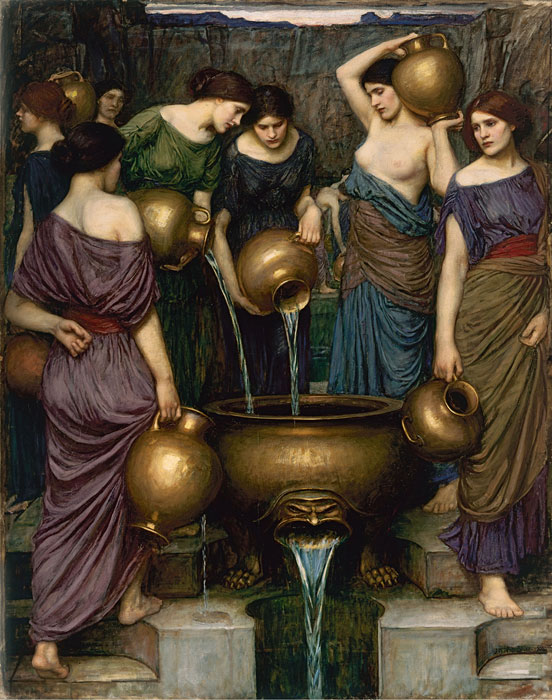The Danaides is the only painting the English artist John William WaterhouseEnglish artist known primarily for his depictions of women set in scenes from myth, legend or poetry. He is the best known of that group of artists who from the 1880s revived the literary themes favoured by the Pre-Raphaelites. submitted to the Royal Academy exhibition in 1906. Capturing a scene from Greek mythology, it portrays the Danaides – the daughters of King Danaus – in Hades. A similar, smaller version, dated 1904, was found later, but the composition includes fewer figures.
Description
The fifty daughters of King Danaus, or the Danaides as the nymphs were collectively termed, were forced or persuaded to marry the fifty sons of the King’s twin brother, Aegyptus, in a mass ceremony. The precise details of the myth are inconsistent but all the Danaides except one killed their bridegrooms, possibly with daggers, while the men slept. The victims were decapitated. The punishment conferred on the maidens for their crimes was to fruitlessly labour for eternity in Hades, endlessly replenishing a leaking container with water.[1] The painting depicts Waterhouse’s interpretation of the Danaides undertaking their penance in the underworld.[2]
Echoing a sketch of the Danaides used in Smith’s Classical Dictionary, a book the historian Peter Trippi implies the artist was familiar with, Waterhouse has the maidens pouring water into a pot. He has embellished the pot by transforming the hole where the water escapes into a scowling face and mounted it on clawed feet giving the pot an aura of menace. The overall effect is heightened by the sense of confinement produced by the rugged cliffs forming the background.[3] Above the cliffs, barely discernible below the frame, viewers are shown a fleeting glance of blue mountains under the skyline.[4]
Waterhouse previously used the magic number seven as the basis for how many figures to include; for instance, seven sirens appear in Ulysses and the Sirens (1891) and seven nymphs are included in Hylas and the NymphsHylas and the Nymphs is a painting by the English artist John William Waterhouse, exhibited at the Royal Academy Summer Exhibition in 1897. It shows the Greek hero Hylas being enticed to his death into a pool of water by a group of nymphs. (1896).[5] In The Danaides, he portrays seven of the fifty maidens each carrying a burnished pitcher. The same type of jug was used six years earlier in Nymphs Finding the Head of Orpheus; academic Elizabeth Prettejohn suggests that in both paintings the jugs represent severed heads.[5] Each of the figures have been styled using the same model.[6]
Earlier version
Signed and dated 1904, this alternate oil on canvas rendition of The Danaides features five rather than seven figures. Writing in 1989, academic Anthony Hobson describes the painting as “recently discovered”.[2][a]Hobson gives no further indication as to when or where it was discovered; the 1904 version is not mentioned in Hobson’s earlier 1980 work, The Art and Life of J W Waterhouse, and it does not appear in the Catalogue of Works included in that publication. The painting is reproduced in his 1989 book, J W Waterhouse (p. 106), acknowledging it is “Courtesy Christie’s New York”. The colour palette is less restrained than that of the later work.[7]
Exhibitions and provenance
The later version was Waterhouse’s only submission to the Royal Academy of Arts exhibition in 1906.[8] Immediately purchased from the artist by James Murray,[b]James Murray (1850–1933), knighted in 1915, was the Liberal Member of Parliament for East Aberdeenshire, an artist with exhibits at the Royal Academy who went on to become a noted art collector;[9] Trippi further describes Murray as “the beef and tanning magnate”.[10] who owned it until he sold his collection on 29 April 1927 at Christie’s.[11] Acquired by Aberdeen Art Gallery at the auction for £1000 guineas using funds received from the Macdonald bequest,[12] it remains part of the gallery’s collection.[13]
Early records do not indicate the 1904 version as being exhibited.[5] It was acquired by Andrew Lloyd Webber in 1995; no other provenance details are listed. In 2002 Lloyd Webber added a study for The Danaides to his collection; measuring 38.5 centimetres (15.2 in) by 31 centimetres (12 in), it had been sold by the artist’s widow, Esther Kenworthy WaterhouseEnglish artist, specialist in flower painting; her husband was fellow artist John William Waterhouse, at Christie’s on 23 July 1926.[14]
Notes
| a | Hobson gives no further indication as to when or where it was discovered; the 1904 version is not mentioned in Hobson’s earlier 1980 work, The Art and Life of J W Waterhouse, and it does not appear in the Catalogue of Works included in that publication. The painting is reproduced in his 1989 book, J W Waterhouse (p. 106), acknowledging it is “Courtesy Christie’s New York”. |
|---|---|
| b | James Murray (1850–1933), knighted in 1915, was the Liberal Member of Parliament for East Aberdeenshire, an artist with exhibits at the Royal Academy who went on to become a noted art collector;[9] Trippi further describes Murray as “the beef and tanning magnate”.[10] |


